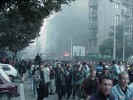March 2000: Kosovo: One Year Later
Nearly one
year after NATO first intervened in Kosovo, it appears the alliance has failed to fulfill
its chief objectives, both in waging the war and keeping the peace. Increasingly,
Kosovo seems beyond the alliance’s control as crime, weapons and drug trafficking
resurface. Alliance forces are now on the defensive against former allies within the
ethnic Albanian community; the guerrillas of the Kosovo Liberation Army (KLA) now appear
to hold positions of considerable power. Nine months after the war, the West faces a
choice. It can increase its grip on Kosovo, committing more troops and confronting the
KLA, or the alliance can resign itself to losing control of Kosovo.
NATO’s war against Yugoslavia set a precedent at
considerable cost. It was the first instance of unilateral NATO
intervention in a sovereign nation during the alliance’s 50-year history. NATO
sent more than 1,000 aircraft to fly more than 38,000 sorties, at an eventual estimated
cost of tens of billions of dollars. The alliance deployed 38,000 peacekeepers, drawn from
28 countries, with no foreseeable end to their mission. Reconstruction has barely begun
and is expected to cost another $32 billion.
But one year later, the
alliance’s peacekeeping mission, known as KFOR, is failing. Not only does ethnic violence persist, but the alliance appears to be
further losing control. The murder rate in the rural breakaway province now equals that of
the world’s largest cities. Sources on the ground report that weapons are
increasingly in the hands of former guerrillas. NATO troops have come under attack
by the ethnic Albanian majority as well as the Serb minority. The alliance is steadily
headed toward a daunting choice. It must increase its grip on Kosovo or resign itself to
providing a garrison force that safeguards a tumultuous province, which is effectively in
the hands of the KLA.
Kosovo’s
State of Violence
KFOR entered
the province to fulfill three missions: to ensure safety, enforce compliance with the June
1999 cease-fire agreements and temporarily assist the United Nations with civilian
functions, such as policing and reconstruction. But Kosovo has steadily become an
upside-down world of reversed roles. The guerrillas were supposed to disarm and disband
but have in fact maintained a strong hold on power. Increasingly, KFOR troops are
defending themselves apparently against their wartime allies in the KLA.
It appears that elements of the
guerrillas are orchestrating violence that threatens international forces. Even
Western military officials have come grudgingly, though privately, to the conclusion that
extremist elements of the KLA are making a bid for outright independence. NATO troops were stoned last October in the western city of Pec. The
recent violence in the northern city of Mitrovica included a grenade attack that wounded
17 KFOR troops. In February, KFOR Cmdr. Gen. Klaus Reinhardt
said, "When NATO came into Kosovo we were only supposed to fight the Yugoslav army if
they came back uninvited. Now we’re finding we have to fight the Albanians."
Violent crime is falling but the largely rural province is
far from safe. In the southeast corner of Kosovo, the American sector, there were 615
incidents of hostile fire, 15 mortar attacks, 20 altercations with unruly crowds, 129
grenade attacks and 58 landmine explosions – in the first six months of peacekeeping,
according to NATO figures. The murder rate for the entire province has dropped from 127
murders per 100,000 people at the end of the war to 23 murders per 100,000. Still, the
murder rate of rural Kosovo now equals the murder rate of Los Angeles, California –
one of the world’s largest and most densely populated cities.
Under the June cease-fire agreement, the KLA was supposed
to disband and disarm, but there is evidence that former guerrillas now enjoy easy –
even sanctioned – access to weapons. Some 5,000 former KLA guerrillas have joined the
Kosovo Protection Corps (KPC), a sort of national guard for emergency and disaster
response. They are allowed to carry sidearms with the proper permit cards. But the permit
cards are being copied and distributed to other former guerrillas, according to an
international police source.
The Power of
the KLA and Drug Trafficking
In many ways, the state of affairs
in Kosovo is the result of a lack of government. The United Nations has never had a
complete plan to set up a government; nine months after peacekeeping began there is none.
In this vacuum, the KLA has flourished.
While the KLA was to have disbanded, two important wartime
figures remain at the core of the still existent KLA power structure. Hashim Thaci, who led the KLA’s political wing and became the chief
contact for the West, is now Kosovo’s most important ethnic Albanian politician. The
commander of the KLA’s military wing, Agim Cequ, commands 5,000 former guerrillas who
are now in the Kosovo Protection Corps.
The KLA is indebted to Balkan drug
organizations that helped funnel both cash and arms to the guerrillas before and after the
conflict. Kosovo is the heart of a heroin trafficking route that runs from Afghanistan
through Turkey and the Balkans and into Western Europe. It now appears that the KLA
must pay back the organized crime elements. This would in turn create a surge in heroin
trafficking in the coming months, just as it did following the NATO occupation of Bosnia
in the mid-1990s.
Two to six tons of heroin, worth 12 times its weight in
gold, moves through Turkey toward Eastern Europe each month. The route connecting the
Taliban-run opium fields of Afghanistan to Western Europe’s heroin market is worth an
estimated $400 billion a year – and is dominated by the Kosovar Albanians. This
"Balkan Route" supplies 80 percent of Europe’s heroin.
For the KLA, the Balkan Route is not
only a way to ship heroin to Europe for a massive profit, but it also acted as a conduit
for weapons filtering into the war-torn Balkans. The smugglers either trade drugs
directly for weapons or buy weapons with drug earnings in Albania, Bosnia, Croatia,
Cyprus, Italy, Montenegro, Switzerland or Turkey. The arsenal of weapons smuggled into
Kosovo has included: anti-aircraft missiles, assault rifles, sniper rifles, mortars,
shotguns, grenade launchers, anti-personnel mines and infrared night vision gear,
according to a NATO report cited in the Washington Times in June 1999.
There is already anecdotal evidence
that the drug trade is flourishing in Kosovo, in full view of international authorities.
The bombed out, unpaved streets of Kosovo are the new home to sleek European sports cars
with no license plates. There are 20 percent to 25 percent more cars in Kosovo than
there were before the war, according to an international police official recently returned
from several months in Kosovo. The refugees claim Serbs took the
plates, but the black Mercedes are signs of a prospering drug trade.
Beyond Kosovo
Drug smuggling will make an impact
beyond the Balkans and deep into the rest of Europe. Ethnic Albanians are the predominant
smugglers in the Western European heroin market, according to Interpol data.
Some 500,000 Kosovar Albanians live in Western Europe.
Those living off the heroin trade rely on clan loyalties to tightly control their business
partners. They gain access to Western European cities by exploiting their reputation as
refugees. This gives them a distinct advantage over the Turks or Italians.
Although Albanian speakers comprise
about 1 percent of Europe’s 510 million residents, they made up 14 percent of all
Europeans arrested for heroin smuggling in 1997, according to Interpol. The average
quantity of heroin confiscated from arrested smugglers was two grams; ethnic Albanians
arrested for the same crime carried an average of 120 grams, the agency said.
The U.S. government has been – and
likely continues to be – well aware of the heroin trade coming through Kosovo, as well as the KLA connection. Just two years before the
war, the Clinton administration wanted national security waivers for 14 countries -
including Yugoslavia - in order to send arms and stem drug trafficking. The U.S. Drug
Enforcement Agency reported in 1998 that ethnic Albanian organizations in Kosovo are
"second only to Turkish gangs as the predominant heroin smugglers along the Balkan
route."
Today, Kosovo poses for NATO an ironically similar
problem to the one it posed in 1999. Kosovo's problems - smuggling, crime and violence -
threaten to spill out into the Balkan region. Tensions between the Serbs and ethnic
Albanians challenge stability in Montenegro and Serbia, the remaining Yugoslav republics.
The alliance must not only contain Kosovo's problems, but prevent renewed war between the
KLA and Yugoslav forces in Serbia.
Montenegro threatens to become the next hot spot as
a result of the Kosovo war. The province's leadership has taken its cues from the
international community's defense of Kosovo. Montenegrin President Milo Djukanovic has
announced that the West is ready to offer help in the event of a Serb attack. Officials
from the U.N. and human rights groups have made increasingly loud requests for Western
attention to Montenegro.
NATO's Next Move
NATO now faces a dilemma. It must take control of
the situation in Kosovo by increasing its troop presence and confronting its former allies
in the KLA. Or the alliance can accept a role as vassal to the guerrillas, essentially
safeguarding Kosovo from a Serbian invasion. The guerrillas, in turn, would run Kosovo as
they see fit.
Withdrawing altogether from Kosovo is out of the
question; Yugoslav forces would quickly pour into the province. The prospect of vastly
increasing forces is unpleasant. As it stands now NATO members are reluctant to deploy
even enough troops to meet the current mandate of 50,000 peacekeepers.
To maintain control, though, the alliance must do
more than increase its presence; it must reconsider its allies in Kosovo. There are signs that the West may play a longtime moderate, Ibrahim
Rugova, against Thaci. During his recent trip to Kosovo, State Department spokesman James
Rubin met with Rugova, the first high-level public contact between U.S. officials and
Rugova since he was abandoned last year. The prospect is
stark. NATO would have to crush the KLA, risking more violence and a public relations
nightmare.
NATO's other option is probably even more
unappealing: handing the KLA the keys to Kosovo. In such a scenario, the alliance would
give ethnic Albanian political and civil leaders - with a few Serbs thrown in to
demonstrate multi-ethnic governance - political control. But in fact
the KLA would retain the upper hand. Alliance troops would remain to safeguard whatever
state the former guerrillas choose to build.


